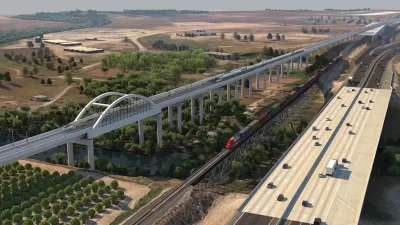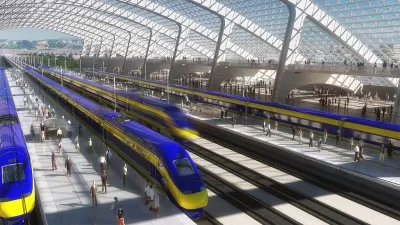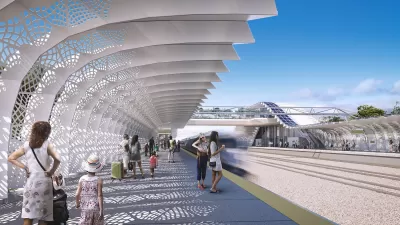The historic precipitation that fell on the state of California in past months poses a unique and unanticipated threat to the state’s big infrastructure project in the Central Valley.

“Recent rainstorms that have created flooding in some parts of Kings and Tulare counties have also ground work to a halt at several key construction sites for California’s high-speed rail project,” Tim Sheehan for the Fresno Bee. While several work sites are shut down due to the current flooding, officials expect the problem to continue into the summer, as a historic snow pack melts and sends even more water down the state’s various waterways.
Work is continuing along other stretches of the 119-mile stretch of the rail line currently under construction, but on sections impacted by flooding, construction crews have been working to help protect communicates from flooding, according to the article.
Meanwhile, high-speed rail officials report that the project is proving as resilient as it was designed. “The rail line has been designed to cope major floods; viaducts and a railbed that will elevated above the level of the surrounding land are expected to minimize the risk of damage from future floods,” according to the source cited in the article below.
“But it’s the seasonal flow of irrigation ditches and canals that the rail line must cross that represent uncertainty in how fast work can progress this coming fall and winter,” according to Sheehan.
The California High-Speed Rail project has faced numerous challenges through the years, from shifting political winds to cost overruns and planning challenges.
FULL STORY: California’s beleaguered bullet train faces another hurdle: flooding from melting snow

Study: Maui’s Plan to Convert Vacation Rentals to Long-Term Housing Could Cause Nearly $1 Billion Economic Loss
The plan would reduce visitor accommodation by 25,% resulting in 1,900 jobs lost.

North Texas Transit Leaders Tout Benefits of TOD for Growing Region
At a summit focused on transit-oriented development, policymakers discussed how North Texas’ expanded light rail system can serve as a tool for economic growth.

Using Old Oil and Gas Wells for Green Energy Storage
Penn State researchers have found that repurposing abandoned oil and gas wells for geothermal-assisted compressed-air energy storage can boost efficiency, reduce environmental risks, and support clean energy and job transitions.

Private Donations Propel Early Restoration of Palisades Playground
Los Angeles has secured over $1.3 million in private funding to restore the Pacific Palisades playground months ahead of schedule, creating a modern, accessible space that supports community healing after recent wildfires.

From Blight to Benefit: Early Results From California’s Equitable Cleanup Program
The Equitable Community Revitalization Grant (ECRG) program is reshaping brownfield redevelopment by prioritizing projects in low-income and environmental justice communities, emphasizing equity, transparency, and community benefits.

Planting Relief: Tackling Las Vegas Heat One Tree at a Time
Nevada Plants, a Las Vegas-based nonprofit, is combating the city’s extreme urban heat by giving away trees to residents in underserved neighborhoods, promoting shade, sustainability, and community health.
Urban Design for Planners 1: Software Tools
This six-course series explores essential urban design concepts using open source software and equips planners with the tools they need to participate fully in the urban design process.
Planning for Universal Design
Learn the tools for implementing Universal Design in planning regulations.
Ascent Environmental
Borough of Carlisle
Institute for Housing and Urban Development Studies (IHS)
City of Grandview
Harvard GSD Executive Education
Toledo-Lucas County Plan Commissions
Salt Lake City
NYU Wagner Graduate School of Public Service





























